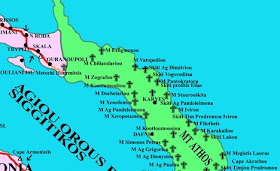 Many disappointed Christians from many denominations turn to eastern traditions in order to experience the infinite. Most of them feel highly attracted by Indian gurus or Tibetan monasteries, but few of them know about the rich Christian Orthodox tradition in Mount Athos. The deep experience of God in what has been called the monastic republic of Mount Athos, is so unique that it is necessary to make it known to the wider public.
Many disappointed Christians from many denominations turn to eastern traditions in order to experience the infinite. Most of them feel highly attracted by Indian gurus or Tibetan monasteries, but few of them know about the rich Christian Orthodox tradition in Mount Athos. The deep experience of God in what has been called the monastic republic of Mount Athos, is so unique that it is necessary to make it known to the wider public.The origins of this place are legendary, but historians affirm that the easternmost "arm" of the Halkidiki peninsula in northern Greece has been populated by monks since the 3th or 4th century, wich means it has been considered a sacred place for more than 1700 years. The legend says that the Holy Virgin Mary was sailing throgh the area with Saint John, on her way to see Lazarus in Cyprus, and some treacherous winds send them to this place. The Virgin was so overwhelmed by the beauty of the place that she asked God to keep it as her personal garden. God responded by saying: Ἔστω ὁ τόπος οὖτος κλῆρος σὸς καὶ περιβόλαιον σὸν καὶ παράδεισος, ἔτι δὲ καὶ λιμὴν σωτήριος τῶν θελόντων σωθῆναι" (Translation: "Let this place be your inheritance and your garden, a paradise and a haven of salvation for those seeking to be saved"). Ever since that day women are not allowed in the area, a very helpful policy for a place where celibacy is strictly observed.
In recent tiimes, the peninsula is populated by nearly 2200 monks, distributed in 20 monasteries. The architectural beauty and the different styles that are present in Athos is one of the most impressive features of the esthetic experience of visiting this holy place. But the real attractive is the spiritual power of the beautiful and ancient liturgies the monks celebrate: masses, liturgical vestments, choirs, incense, breathtaking icons, wall paintings and the natural beauty surrounding the different monasteries make the visit unforgettable.
 A UNESCO world heritage, Mount Athos is accessible only by boat. Pilgrimages are controlled through a special permit (diamoneterion) every pilgrim should have in order to board the boats. The closest main city is Thesalonikki, but from there pilgrims have to travel to Ouranopolis, where they can embark. Boats arrive at Dafni and from there they can continue to the capital of Mount Athos, the town of Karyes. The other option is to continue in smaller boats to other monasteries by the coastline.
A UNESCO world heritage, Mount Athos is accessible only by boat. Pilgrimages are controlled through a special permit (diamoneterion) every pilgrim should have in order to board the boats. The closest main city is Thesalonikki, but from there pilgrims have to travel to Ouranopolis, where they can embark. Boats arrive at Dafni and from there they can continue to the capital of Mount Athos, the town of Karyes. The other option is to continue in smaller boats to other monasteries by the coastline.The permits allow two types of visit. The first one allows the pilgrim to stay only one night in different monasteries during a few days, and the secoind one allows to stay in only one monastery as many days as the pilgrim is allowed by the monks.
The first, and still the most important, monastery, the Great Lavra or Meyistis Lavras ("Lavra" means a community of monks), was founded around 960, and others quickly followed. In 1060, an imperial decree barred "every woman, every child, eunuch, smooth faced person, and female animal" from Athos, which suggests that there had been incidents of inventive nonchastity over the years. In recent years, hens have been allowed onto Athos to produce eggs, and cats to catch vermin.
 Today, there are 20 active monasteries, with at least that many again closed over the centuries. Solitary hermits still live on Athos, but most monks follow a communal rather than an isolated life. In fact, monastic life has had something of a revival; Father Gabriel, gardener at the Iviron Monastery, was quoted in the July 28, 1998, Athenian newspaper Kathimerini as saying, "More are interested in becoming monks than we are ready to accept." According to the same story, Father Gabriel has added to his gardening duties the preparation of a computer catalog of manuscripts and icons. When asked if this would take a very long time, he replied, "We've got all eternity."
Today, there are 20 active monasteries, with at least that many again closed over the centuries. Solitary hermits still live on Athos, but most monks follow a communal rather than an isolated life. In fact, monastic life has had something of a revival; Father Gabriel, gardener at the Iviron Monastery, was quoted in the July 28, 1998, Athenian newspaper Kathimerini as saying, "More are interested in becoming monks than we are ready to accept." According to the same story, Father Gabriel has added to his gardening duties the preparation of a computer catalog of manuscripts and icons. When asked if this would take a very long time, he replied, "We've got all eternity."

No hay comentarios.:
Publicar un comentario
¿Qué opinas de esto? Deja tu comentario!